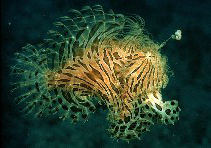Striated frogfish

Common Name: Striated frogfish
Scientific Name: Antennarius striatus
DESCRIPTION
The fish looks strange and a master in camouflage. It can completely change its color to match its surroundings within a few weeks. The illicium rod of the frogfish is topped with worm like lure appendages regenerates again if its lost. It twitches its 'rod and lure' to attract its prey, and it gulps them up quickly. It can also swallow prey that are almost twice of its size.
DIET
In these kind of fishes, Feeding behavior is quite unique. Using its eye the frogfish follows the movement of the prey when the prey is detected. It surprisingly attacks the prey by preparing slowly with the prediction. When it suddenly opens its jaws which increases the mouth size up to 12 times, then they prey gets caught as predicted.
BEHAVIOUR
In these kind of fishes, Feeding behavior is quite unique. It has various benthic fishes such as flounders, shrimp gobies and it feeds on crustaceans.
HABITAT
The striated frogfish resides in rocky, sandy, and remains in habitats as well as coral reefs in a subtropical benthic species. In the east coast of southern Africa, it is found in flimsy estuaries.
SPECIAL FEATURES OR HABITS
The dorsal spine consists of 2 to 7 extended appendages. The persuade is a way to distinguish easily A. striatus from Antennarius hispidus, which has a similar physical characteristics which is often confused.
LOCATION OR REGION FOUND
The striated frogfish is found mainly in the subtropical and tropical waters from the Indian Ocean to the middle of the Pacific Ocean. It starts from the New Jersey coast to the southern Brazilian coast and from an Atlantic Ocean to the western coast of Africa that includes Caribbean sea and the Gulf of Mexico.
 Deep Sea Crabs
Deep Sea Crabs